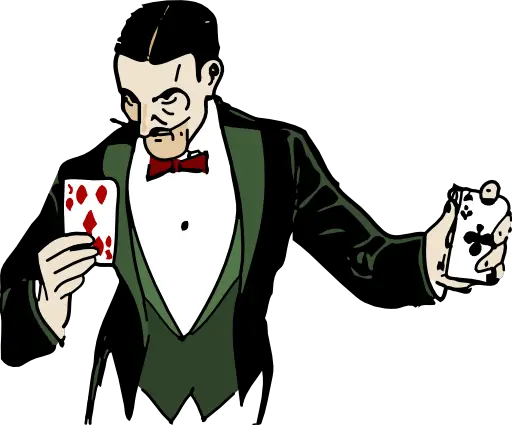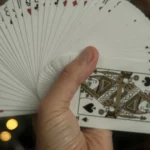Support our educational content for free when you purchase through links on our site. Learn more
7 Mind-Bending Skills That Make Mentalists Masters of the Mind [2024] 🧠
Have you ever watched a mentalist perform and wondered how they do it? It’s not magic, but it’s pretty darn close! Mentalists are masters of the mind, using a blend of psychology, observation, and showmanship to create the illusion of extraordinary mental abilities. Think mind-reading, predicting the future, and even influencing people’s thoughts. They’re like human lie detectors, able to read your body language, decipher your subtle cues, and even guide your decisions.
But how do they do it? It’s not just about knowing a few tricks; it’s about mastering a specific set of skills. In this article, we’ll explore the 7 mind-bending skills that make mentalists masters of the mind. We’ll delve into the psychology behind their techniques, the secrets of observation, and the art of communication that helps them captivate their audience. You’ll even learn some tips and tricks to try out yourself, and discover some of the best resources for learning mentalism. Ready to unlock the secrets of the mind? Let’s dive in!
Quick Answer
- Mentalists are masters of observation, using keen eyesight and attention to detail to read people’s body language and subtle cues.
- They leverage psychology to understand how the human mind works, including cognitive biases, persuasion techniques, and social dynamics.
- They use their communication skills to influence and persuade, employing verbal and nonverbal techniques to subtly guide thoughts and actions.
- They are skilled performers, using showmanship to captivate their audience, create a sense of wonder, and make their illusions even more believable.
👉 Shop Mentalism Resources on:
- Penguin Magic: Official Website | Amazon
Table of Contents
- Quick Tips and Facts
- The Mind-Bending History of Mentalism
- What is Mentalism & What Does a Mentalist Do?
- Mentalism Tricks & Techniques to Learn to Become a Mentalist
- Skills Required to Become a Mentalist
- Popular Books to Learn How to Become a Mentalist
- How to Become a Mentalist? – Courses
- Famous Mentalists in the World
- How to Become a Mentalist? FAQs
- Conclusion
- Recommended Links
- FAQ
- Reference Links
Quick Tips and Facts
Want to become a mentalist and leave your audience spellbound? 🤔 Check out these quick facts:
- Mentalism is more than just tricks: It’s a performing art that blends psychology, suggestion, misdirection, and showmanship. Learn more about the psychology behind magic here.
- It takes more than just a deck of cards: While card tricks can be part of a mentalist’s repertoire, true mentalism delves into the realm of thoughts and influence.
- Practice makes perfect, but observation is key: A keen eye for human behavior, body language, and subtle cues is a mentalist’s greatest asset.
- Ethics matter: Use your skills responsibly and avoid exploiting or manipulating your audience.
Want to see some mind-blowing examples of mentalism in action? Check out our article: 10 Mind-Blowing Examples of Mentalism 2024🤯
The Mind-Bending History of Mentalism
Mentalism, with its air of mystery and mind-reading prowess, might seem like a modern invention. But its roots stretch far back in time, intertwining with spirituality, mysticism, and early forms of entertainment.
Ancient Origins
Imagine ancient oracles and seers, shrouded in mystery, claiming to communicate with the divine. These figures, often revered and feared, were early practitioners of what we might now call mentalism. They relied on observation, intuition, and a deep understanding of human psychology to offer guidance, predictions, and sometimes even manipulate those around them.
From Stage Shows to Psychological Exploration
Fast forward to the 1800s, and mentalism takes a theatrical turn. Stage magicians, eager to capitalize on the public’s fascination with the paranormal, incorporated mind-reading acts and psychic illusions into their shows. These early mentalists, often shrouded in an aura of supernatural powers, captivated audiences with feats of telepathy, clairvoyance, and precognition.
But mentalism wasn’t just about entertainment. The late 19th and early 20th centuries saw a surge of interest in the human mind. Psychologists like Sigmund Freud delved into the depths of the subconscious, exploring the hidden workings of our thoughts and behaviors. Mentalists, always keen observers of human nature, drew inspiration from these psychological discoveries, refining their techniques and developing more sophisticated acts.
The Rise of the Modern Mentalist
Today, mentalism occupies a unique space, blending entertainment with psychology, suggestion, and illusion. Modern mentalists, like the renowned Derren Brown, openly acknowledge that their performances are based on skill, observation, and a deep understanding of human behavior. They often use their platform to debunk pseudoscience, expose fraudulent psychics, and promote critical thinking.
From ancient oracles to modern-day performers, mentalism continues to captivate and intrigue. It’s a testament to the power of the human mind, both in its ability to deceive and its endless capacity for wonder.
What is Mentalism & What Does a Mentalist Do?
Mentalism, in its simplest form, is the art of creating the illusion of extraordinary mental abilities. But it’s so much more than just reading minds or predicting the future (although those are some pretty cool party tricks, right? 😉).
The Illusion of the Mind
Mentalists are masters of observation, suggestion, and psychological manipulation. They use these skills to create compelling performances that leave audiences wondering, “How did they DO that?”
Here’s a glimpse into the world of mentalism:
- Mind Reading: A mentalist might ask you to think of a childhood memory or a secret wish, and then proceed to reveal it with astonishing accuracy.
- Predictions: Imagine a sealed envelope containing a prediction, made days in advance, that aligns perfectly with a choice you make during the performance. Spooky, right?
- Influence: A mentalist might guide your decisions, subtly influencing you to choose a specific card or object, all while making you believe you’re acting of your own free will.
- Telekinesis: From bending spoons with their minds to levitating objects, mentalists can create the illusion of moving objects with the power of thought.
The Tools of the Trade
While mentalists might not have supernatural powers (shhh, don’t tell anyone!), they do rely on a unique set of skills and techniques:
- Psychology: Understanding how the human mind works, from cognitive biases to patterns of behavior, is essential for a mentalist.
- Suggestion: Mentalists use subtle cues, body language, and language patterns to plant ideas and influence thoughts.
- Misdirection: Just like a magician, a mentalist will use distraction and misdirection to draw your attention away from the “method” behind their tricks.
- Showmanship: A dash of charisma, a sprinkle of humor, and a whole lot of stage presence are crucial for creating a truly captivating performance.
Beyond Entertainment
Mentalism is more than just a form of entertainment. It can also be a powerful tool for:
- Exploring the human mind: Mentalism forces us to confront our own perceptions and question the limits of our abilities.
- Promoting critical thinking: By exposing the methods behind seemingly impossible feats, mentalists encourage us to think skeptically and question what we see.
- Personal development: The skills used in mentalism, such as observation, communication, and influence, can be applied to various aspects of life, from business negotiations to personal relationships.
Mentalism Tricks & Techniques to Learn to Become a Mentalist
Ready to delve into the fascinating world of mentalism and learn the tricks of the trade? Here are some popular techniques used by mentalists to astound and amaze:
1. Cold Reading
Think Sherlock Holmes meets Derren Brown. Cold reading is the art of making educated guesses about a person based on their appearance, body language, and responses to carefully crafted questions.
- How it Works: Mentalists use a combination of observation, psychology, and subtle cues to gather information about a person.
- Example: A mentalist might observe a person’s wedding ring, a worn-out book in their bag, or their hesitant body language to deduce details about their life, relationships, or aspirations.
2. Hot Reading
Ever wonder how some psychics seem to know so much about their clients? Sometimes, it’s a matter of a little “pre-show” research.
- How it Works: Hot reading involves gathering information about a person before the performance. This could involve researching their social media profiles, planting an accomplice in the audience, or using subtle pre-show interactions to glean personal details.
- Example: A mentalist might ask audience members to write down their questions on cards before the show, giving them the opportunity to peek at the questions or even switch them out for pre-written ones.
3. Suggestion and Influence
Mentalists are masters of persuasion, subtly guiding your thoughts and actions without you even realizing it.
- How it Works: They use a combination of verbal cues, body language, and psychological principles to implant ideas and influence decisions.
- Example: A mentalist might subtly emphasize certain words or phrases, use leading questions, or mirror your body language to create a sense of rapport and increase their influence.
4. Misdirection and Sleight of Hand
Just like magicians, mentalists use misdirection to their advantage, diverting your attention away from the “method” behind their tricks.
- How it Works: They might use humor, storytelling, or dramatic gestures to distract you while they perform a secret move or switch out an object.
- Example: A mentalist might ask you to focus on a specific object in their hand, all while subtly palming another object or making a secret switch.
5. Memory Techniques
Mentalists often perform feats of memory, memorizing long lists of numbers, names, or objects with incredible speed and accuracy.
- How it Works: They use mnemonic devices, visualization techniques, and memory palaces to encode and retrieve information efficiently.
- Example: A mentalist might use a memory palace, creating a mental map of a familiar location and associating each item on a list with a specific object or room in that location.
6. Body Language Reading
From subtle facial expressions to unconscious gestures, our bodies reveal a wealth of information about our thoughts and feelings.
- How it Works: Mentalists are skilled at reading these nonverbal cues, interpreting them to gain insights into a person’s emotional state, intentions, or even their next move.
- Example: A mentalist might notice a person’s pupils dilate when they’re shown a particular image, or observe a subtle shift in their posture when they’re asked a sensitive question.
These are just a few of the many tricks and techniques used by mentalists to create their mind-bending performances. Remember, practice, observation, and a deep understanding of human psychology are key to mastering these skills.
Skills Required to Become a Mentalist
So you think you’ve got what it takes to become a mentalist? It’s more than just knowing a few card tricks or being able to read someone’s mind (or at least make them think you can!). Here are the essential skills you’ll need to hone:
1. The Art of Observation: Become a Human Lie Detector
Mentalists are masters of observation, noticing the smallest details that others miss. They pay attention to:
- Body Language: A slight shift in posture, a fleeting microexpression, a nervous fidget—these are all telltale signs that a mentalist can use to their advantage.
- Verbal Cues: Tone of voice, word choice, even the pauses and hesitations in someone’s speech can reveal hidden thoughts and emotions.
- Environmental Clues: From the books on a person’s shelf to the photos on their desk, mentalists pick up on environmental cues that provide insights into a person’s life, interests, and personality.
Pro Tip: Start by observing people in everyday situations. Pay attention to their body language, their interactions with others, and the subtle cues they give off. You’ll be amazed at how much you can learn just by paying attention.
2. Psychology: Unravel the Mysteries of the Mind
To truly understand how to influence and manipulate (for entertainment purposes, of course!), you need to understand the inner workings of the human mind. Study:
- Cognitive Biases: These mental shortcuts, while helpful in everyday life, can also make us predictable and susceptible to manipulation.
- Persuasion Techniques: From reciprocity to scarcity, there are countless psychological principles that influence our decisions and behaviors.
- Social Dynamics: Understanding how people interact in groups, the power of conformity, and the dynamics of influence are all valuable tools for a mentalist.
Pro Tip: Read books on psychology, persuasion, and human behavior. Some great places to start include “Influence: The Psychology of Persuasion” by Robert Cialdini and “Thinking, Fast and Slow” by Daniel Kahneman.
3. Communication: Become a Master of Words
Mentalists are captivating storytellers, weaving tales that engage their audience and make their illusions all the more believable. They master:
- Verbal Communication: Clear articulation, a confident tone, and the ability to adapt your language to different audiences are crucial.
- Nonverbal Communication: Your body language, facial expressions, and even your eye contact all play a role in how your message is received.
- Hypnotic Language Patterns: While not all mentalists use hypnosis, understanding hypnotic language patterns can enhance your ability to influence and persuade.
Pro Tip: Join a public speaking group, take an improv class, or practice your storytelling skills with friends and family. The more you practice communicating effectively, the more confident and persuasive you’ll become.
4. Showmanship: Captivate Your Audience
A great mentalist is also a skilled performer, able to captivate their audience and create an unforgettable experience. Focus on developing:
- Stage Presence: Command attention, move with confidence, and use your body language to engage your audience.
- Charisma: Be likable, approachable, and create a connection with your audience.
- Storytelling: Weave compelling narratives that draw your audience in and make your illusions even more impactful.
Pro Tip: Attend live performances of magicians, mentalists, and other stage performers. Pay attention to how they interact with the audience, their stage presence, and the elements that make their performances so engaging.
Remember, becoming a skilled mentalist takes time, dedication, and a genuine fascination with the human mind. Keep practicing, keep learning, and never stop exploring the amazing potential of your own mind! 🧠✨
Popular Books to Learn How to Become a Mentalist
Ready to unlock the secrets of mentalism and embark on your journey to becoming a master of the mind? These books will be your trusted guides, offering valuable insights, techniques, and inspiration:
1. “13 Steps to Mentalism” by Tony Corinda
Considered the bible of mentalism, this comprehensive guide covers everything from cold reading and suggestion to hypnosis and stagecraft.
- Why it’s Essential: Corinda breaks down complex techniques into easy-to-understand steps, making it an ideal starting point for aspiring mentalists.
👉 CHECK PRICE on:
- 13 Steps to Mentalism: Amazon
2. “Tricks of the Mind” by Derren Brown
Delve into the mind of one of the world’s most renowned mentalists. Brown shares his insights on psychology, suggestion, and the art of creating seemingly impossible illusions.
- Why it’s Essential: Brown’s writing is engaging, insightful, and often humorous, offering a unique perspective on the world of mentalism and the power of the human mind.
👉 CHECK PRICE on:
- Tricks of the Mind: Amazon
3. “Practical Mental Magic” by Theodore Annemann
This classic text, originally published in 1948, remains a valuable resource for mentalists of all levels. It features a wide range of tricks, techniques, and routines, all explained in detail.
- Why it’s Essential: Annemann’s clear and concise writing style makes even complex techniques accessible to beginners, while experienced mentalists will appreciate the wealth of material and creative ideas.
👉 CHECK PRICE on:
- Practical Mental Magic: Amazon
4. “The Artful Mentalism of Bob Cassidy” by Bob Cassidy
Cassidy, a renowned mentalist and author, shares his unique approach to mentalism, emphasizing subtlety, psychology, and the creation of truly baffling illusions.
- Why it’s Essential: Cassidy’s routines are known for their elegance, deceptiveness, and thought-provoking nature.
👉 CHECK PRICE on:
- The Artful Mentalism of Bob Cassidy: Amazon
5. “Mindfreak: Secret Revelations” by Criss Angel
While known for his grand illusions and daredevil stunts, Criss Angel also delves into the realm of mentalism in this revealing book.
- Why it’s Essential: Angel provides a behind-the-scenes look at some of his most famous illusions, offering insights into the techniques, preparation, and showmanship involved.
👉 CHECK PRICE on:
- Mindfreak: Secret Revelations: Amazon
6. “Maximum Entertainment” by Ken Weber
This book is a must-read for anyone serious about performing magic or mentalism. Weber emphasizes the importance of showmanship, audience engagement, and creating a truly memorable experience.
- Why it’s Essential: Whether you’re a seasoned performer or just starting out, Weber’s insights will help you elevate your performances and connect with your audience on a deeper level.
👉 CHECK PRICE on:
- Maximum Entertainment: Amazon
These books will provide you with a solid foundation in the art of mentalism. Remember, the real magic happens when you combine knowledge with practice, creativity, and your own unique style.
How to Become a Mentalist? – Courses
Want to fast-track your journey to becoming a mentalist and learn from the best in the business? These courses offer expert guidance, structured lessons, and a supportive community to help you hone your skills:
1. MasterClass – Derren Brown Teaches Mentalism
Learn from the master himself! In this comprehensive MasterClass, Derren Brown shares his insights on psychology, suggestion, misdirection, and the art of creating truly baffling illusions.
- Why It’s Worth Checking Out: Gain access to Brown’s unique perspective and learn the techniques that have made him one of the most respected mentalists in the world.
👉 CHECK PRICE on:
- MasterClass: Official Website
2. Udemy – The Art of Mentalism
Udemy offers a variety of mentalism courses for all levels, from beginner to advanced. Explore topics like cold reading, hypnosis, memory techniques, and stagecraft.
- Why It’s Worth Checking Out: Udemy’s courses are often more affordable than other online learning platforms, and they offer a wide range of instructors and teaching styles to choose from.
👉 CHECK PRICE on:
- Udemy: Official Website
3. Banachek’s Psychological Subtleties
Renowned mentalist and skeptic Banachek offers a range of workshops and online resources focused on the psychology of deception, persuasion, and influence.
- Why It’s Worth Checking Out: Banachek’s approach is grounded in science and critical thinking, providing valuable insights for anyone interested in the human mind and the art of persuasion.
👉 CHECK PRICE on:
- Banachek: Official Website
4. Penguin Magic – Mastering the Art of Mentalism
Penguin Magic, a leading retailer of magic supplies and resources, offers a variety of mentalism DVDs, books, and online tutorials.
- Why It’s Worth Checking Out: Penguin Magic curates a wide selection of high-quality resources from top mentalists and magicians, making it a great one-stop shop for all your learning needs.
👉 CHECK PRICE on:
- Penguin Magic: Official Website
5. Local Magic Shops and Workshops
Don’t underestimate the value of in-person learning! Check out local magic shops, theaters, or community centers for mentalism workshops, classes, or lectures.
- Why It’s Worth Checking Out: In-person learning offers opportunities for hands-on practice, personalized feedback, and networking with other mentalists in your area.
Investing in your education is crucial for becoming a skilled and successful mentalist. These courses and resources provide a great starting point, but remember, the real learning happens when you put in the time, effort, and practice.
Famous Mentalists in the World
The world of mentalism boasts a diverse array of talented performers, each with their unique style and approach. Here are some of the most renowned mentalists who have captivated audiences worldwide:
- Derren Brown: Known for his blend of psychology, suggestion, and showmanship, Brown has become a household name in the UK and beyond. He’s also a vocal advocate for critical thinking and debunking pseudoscience.
- Penn & Teller: This iconic duo has combined magic and mentalism for decades, known for their sharp wit, daring stunts, and willingness to expose the secrets behind their illusions.
- David Blaine: Blaine’s extreme endurance feats and street magic have made him a global phenomenon. He’s also known for his ability to create a sense of wonder and awe through his mentalism routines.
- Criss Angel: Angel’s blend of grand illusions, mentalism, and daredevil stunts has made him a popular figure in the world of magic and entertainment.
- L.A. Marz: Marz is a contemporary mentalist known for his innovative routines and his ability to create a sense of mystery and intrigue.
- Banachek: This mentalist and skeptic is known for his rigorous approach to debunking psychic claims and his focus on the psychology of deception.
These are just a few of the many talented mentalists who have made their mark on the world. Their performances continue to inspire, entertain, and challenge our perceptions of the human mind.
Conclusion
So there you have it! The world of mentalism is a fascinating blend of psychology, illusion, and showmanship. Whether you’re looking to entertain, explore the human mind, or simply learn some cool tricks, mentalism offers a unique and rewarding journey. Remember, the key to becoming a skilled mentalist is to embrace a lifelong love of learning, observation, and the art of persuasion.
Keep practicing, keep observing, and never stop questioning what you see! You might just surprise yourself with what you’re capable of.
Recommended Links
👉 Shop Mentalism Resources on:
- Penguin Magic: Official Website | Amazon
👉 CHECK PRICE on:
- 13 Steps to Mentalism: Amazon
- Tricks of the Mind: Amazon
- Practical Mental Magic: Amazon
- The Artful Mentalism of Bob Cassidy: Amazon
- Mindfreak: Secret Revelations: Amazon
- Maximum Entertainment: Amazon
FAQ
What are the techniques of mentalism?
Mentalists use a wide range of techniques to create the illusion of extraordinary mental abilities. Some of the most common techniques include:
- Cold Reading: Making calculated guesses about a person based on their appearance, responses, and mannerisms.
- Hot Reading: Gathering background information about the audience before the performance.
- Suggestion and Influence: Subtly guiding thoughts and actions through verbal cues, body language, and psychological principles.
- Misdirection and Sleight of Hand: Diverting attention from the secret method behind a trick using distraction and concealed moves.
- Memory Techniques: Using mnemonic devices and visualization techniques to memorize information quickly and accurately.
- Body Language Reading:







